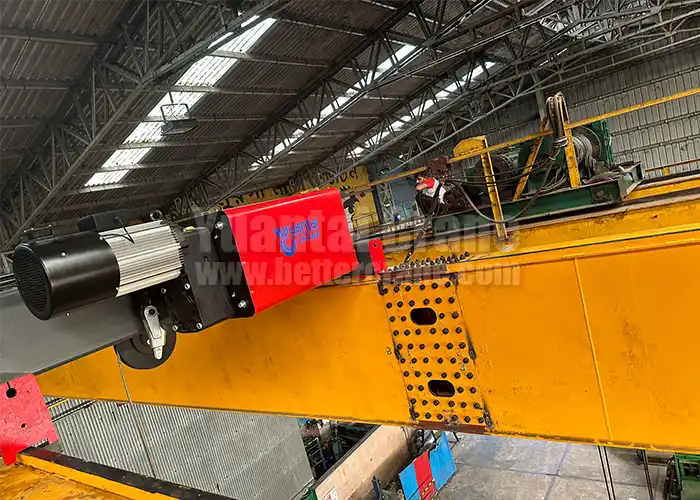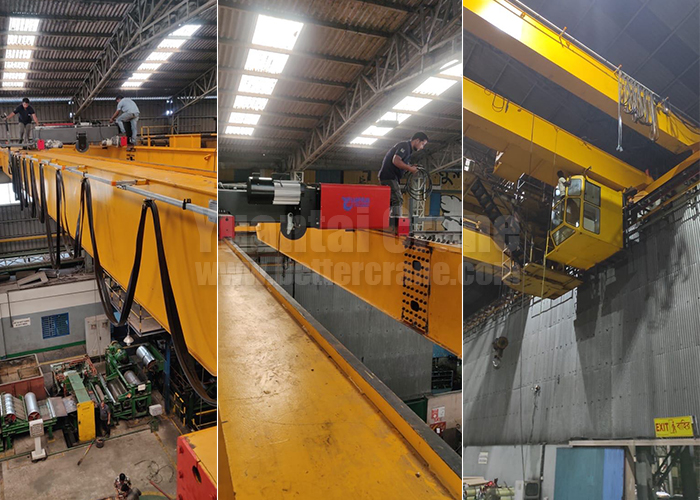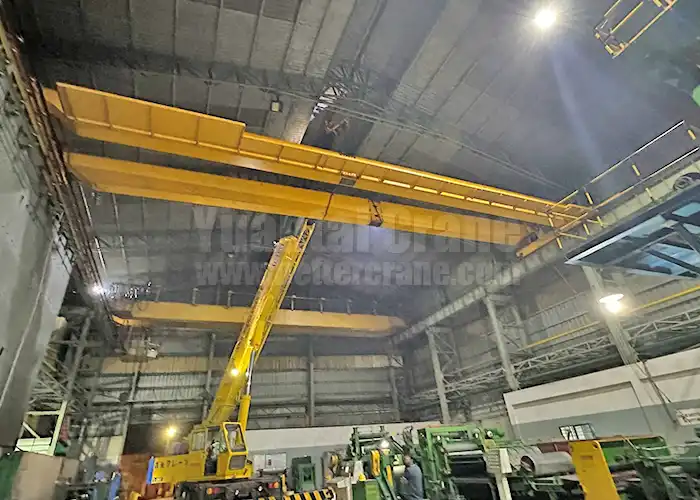15 Ton Overhead Crane for Steel Coil Handling In Bangladesh
15 Ton Overhead Crane for Steel Coil Handling In Bangladesh
15 ton overhead crane for sale Bangladesh. Custom double girder overhead crane 15 ton 20 m span, with builtup hoist for steel coil handling in steel mill.
Bangladesh's steel industry is rapidly evolving, with increasing demand for efficient handling of steel coils in steel mill plants. As part of this evolution, investing in the right equipment becomes paramount. Our project centers around the acquisition of a 15 ton overhead crane tailored for steel coil handling.
Steel coil handling is the backbone of many industrial processes, especially in steel mill plants. Efficient handling ensures smooth operations, timely production, and ultimately, cost-effectiveness. In Bangladesh, where the steel industry is burgeoning, optimizing coil handling processes is crucial for meeting growing demand and staying competitive in the market.Our analysis aims to provide valuable insights for crane buyers in Bangladesh's steel industry. By understanding the technical specifications, market dynamics, feasibility, and operational considerations, buyers can make informed decisions when investing in overhead cranes for steel coil handling. We strive to empower buyers with the knowledge needed to enhance efficiency, safety, and profitability in their operations.

Market Analysis
Bangladesh's steel industry is experiencing rapid growth, fueled by factors such as urbanization, infrastructure development, and industrial expansion. With a burgeoning economy and increasing construction activities, the demand for steel products continues to rise. This necessitates efficient and scalable steel manufacturing processes, where steel coil handling plays a pivotal role.
Demand for Steel Coil Handling Equipment
As the demand for steel products escalates, so does the need for advanced handling equipment. Steel coil handling equipment, including overhead cranes, is essential for seamless operations in steel mill plants. The growing demand for steel coil handling equipment in Bangladesh reflects the industry's quest for efficiency, productivity, and safety. Buyers seek reliable and technologically advanced solutions to meet their evolving needs and enhance their competitive edge.
Competitor Analysis
In a dynamic market like Bangladesh's steel industry, competition is fierce. Various players, both local and international, offer steel coil handling equipment, each vying for market share. Understanding competitors' offerings, pricing strategies, distribution networks, and customer satisfaction levels is crucial for informed decision-making. By conducting a comprehensive competitor analysis, crane buyers can identify strengths, weaknesses, opportunities, and threats, thus refining their procurement strategies.
Growth Potential and Future Trends
The future of the steel industry in Bangladesh looks promising, with sustained economic growth and infrastructural development projects on the horizon. As technology advances and environmental sustainability gains prominence, the industry is poised for innovation and evolution. Key trends such as automation, digitization, and eco-friendly practices are likely to shape the landscape of steel coil handling equipment. Anticipating these trends and aligning procurement decisions accordingly can position buyers for long-term success in a dynamic market environment.
Technical Specifications
In this section, we'll delve into the technical specifications of the 15 ton overhead crane designed for steel coil handling in Bangladesh's steel mill plants.
- Crane Type: Double Girder Overhead Crane :The chosen crane type is the double girder overhead crane, renowned for its robustness, stability, and high lifting capacity. This design ensures optimal performance in heavy-duty applications like steel coil handling, offering reliability and durability even in demanding environments.
- Crane Span: 20 meters :With a generous span of 20 meters, this overhead crane provides ample coverage across the steel mill plant, facilitating efficient movement and handling of steel coils. The wide span enhances flexibility and accessibility, allowing seamless operation throughout the facility.
- Crane Lifting Height: 15 meters : The crane boasts an impressive lifting height of 15 meters, enabling it to reach elevated storage areas and accommodate various production requirements. This vertical capability ensures versatility in handling steel coils of varying sizes and weights, optimizing operational efficiency.
- Crane Voltage: 415V50HZ3P :Operating at 415 volts with a frequency of 50 Hz and three phases, the crane voltage is standardized to meet electrical requirements in Bangladesh. This ensures compatibility with local power systems, facilitating seamless integration and reliable performance.
- European Style Builtup Hoist :Equipped with a European-style built-up hoist, the crane delivers superior lifting performance and precision control. This hoist design is renowned for its durability, efficiency, and ease of maintenance, ensuring uninterrupted operation and minimal downtime.
- Application: Steel Coil Handling in a Steel Mill Plant :Designed specifically for steel coil handling applications, this overhead crane is tailored to meet the unique demands of steel mill plants in Bangladesh. Its robust construction, high lifting capacity, and advanced features make it ideal for safely and efficiently transporting steel coils within the facility.
Project Feasibility
In this section, we'll conduct a comprehensive analysis of the feasibility of acquiring the 15 ton overhead crane for steel coil handling in Bangladesh. This includes assessing costs, ROI projections, and risk factors associated with the project.
Cost Analysis
- Initial Investment: The initial investment comprises the purchase cost of the overhead crane, installation expenses, and any additional infrastructure modifications required for its integration. It's essential to obtain competitive quotations from reputable suppliers and factor in all associated costs to determine the total initial investment accurately.
- Operational Costs: Operational costs encompass expenses related to crane usage, such as electricity consumption, labor wages for crane operators, and periodic inspections. Calculating these ongoing expenses helps estimate the total cost of ownership over the crane's lifespan accurately.
- Maintenance Costs: Regular maintenance is crucial for ensuring the longevity and optimal performance of the overhead crane. Maintenance costs include routine inspections, lubrication, component replacements, and repairs. Estimating these expenses enables proactive budgeting and maintenance planning to minimize downtime and operational disruptions.
ROI Projections
ROI projections involve forecasting the return on investment over a specified period, considering factors such as increased productivity, cost savings, and revenue generation attributed to the crane's deployment. By analyzing potential benefits against investment costs, stakeholders can gauge the project's financial viability and make informed decisions regarding resource allocation.
Risk Assessment
- Market Risks: Market risks encompass fluctuations in steel demand, competitive pressures, and economic uncertainties that may impact the steel industry's performance. Assessing market risks involves analyzing demand-supply dynamics, market trends, and competitor strategies to mitigate potential disruptions to the project's viability.
- Operational Risks: Operational risks pertain to factors that could affect the crane's performance and efficiency, such as equipment breakdowns, operator errors, and production delays. Implementing robust maintenance protocols, operator training programs, and contingency plans can help mitigate operational risks and ensure uninterrupted crane operations.
- Regulatory Risks: Regulatory risks relate to compliance with local regulations, safety standards, and environmental laws governing crane operations in Bangladesh. Non-compliance can lead to legal repercussions, fines, and reputational damage. Therefore, conducting thorough due diligence on regulatory requirements and adhering to best practices is essential to mitigate regulatory risks effectively.
By meticulously assessing costs, ROI projections, and risk factors, stakeholders can make well-informed decisions regarding the acquisition and deployment of the overhead crane for steel coil handling, ensuring a successful and sustainable project outcome.
Operational Considerations
Efficient operation of the 15 ton overhead crane for steel coil handling in Bangladesh requires careful attention to various operational considerations. In this section, we'll delve into key aspects such as process efficiency, safety measures, operator training requirements, and integration with existing infrastructure.
Efficiency of Steel Coil Handling Process
Efficiency in steel coil handling is paramount for maximizing productivity and minimizing downtime in steel mill plants. Factors influencing process efficiency include crane speed, load capacity, material handling techniques, and workflow optimization. By streamlining processes, minimizing idle time, and implementing best practices, operators can enhance overall efficiency and throughput in steel coil handling operations.
Safety Measures
Safety is of utmost importance in steel coil handling operations to prevent accidents, injuries, and damage to equipment or personnel. Implementing robust safety measures involves conducting regular risk assessments, enforcing strict adherence to safety protocols, and providing appropriate personal protective equipment (PPE) for operators. Additionally, installing safety devices such as limit switches, overload protection systems, and emergency stop mechanisms enhances operational safety and minimizes the risk of incidents.
Training Requirements for Operators
Proper training is essential for operators to safely and effectively operate the overhead crane for steel coil handling. Training programs should cover crane operation techniques, safety procedures, maintenance practices, and emergency response protocols. By investing in comprehensive training initiatives, organizations can ensure that operators possess the necessary skills and knowledge to perform their roles competently and mitigate operational risks effectively.
Integration with Existing Infrastructure
Seamless integration of the overhead crane with existing infrastructure is crucial for optimizing operational efficiency and minimizing disruptions during implementation. This involves assessing compatibility with building structures, electrical systems, and workflow layouts. Additionally, coordinating installation schedules, conducting site inspections, and addressing any infrastructure modifications or reinforcements required for crane deployment facilitate smooth integration and minimize downtime.
By prioritizing operational considerations such as efficiency, safety, operator training, and infrastructure integration, stakeholders can maximize the performance and reliability of the 15 ton overhead crane for steel coil handling in Bangladesh's steel mill plants. These measures contribute to enhanced productivity, safety, and profitability in steel coil handling operations, ultimately driving overall business success.
Environmental Impact Assessment
Energy Consumption
Assessing the crane's energy consumption is vital to understand its environmental footprint. Factors influencing energy consumption include motor efficiency, operational duration, and load handling frequency. Implementing energy-efficient components, such as high-efficiency motors and regenerative braking systems, can reduce overall energy consumption and minimize environmental impact.
Emissions and Pollution
Evaluating emissions and pollution associated with crane operation involves analyzing factors such as exhaust emissions from diesel-powered cranes and particulate matter generated during material handling activities. By transitioning to electric-powered cranes and implementing clean energy sources, organizations can mitigate emissions and reduce air pollution in the surrounding environment.
Mitigation Strategies
To mitigate the environmental impact of crane operations, organizations can implement various strategies:
- Energy Efficiency Measures: Implementing energy-saving technologies and practices, such as LED lighting, energy-efficient motors, and automatic shutdown systems, can reduce overall energy consumption and minimize environmental impact.
- Emission Control Technologies: Installing emission control devices, such as catalytic converters and particulate filters, on diesel-powered cranes can mitigate harmful exhaust emissions and minimize air pollution.
- Renewable Energy Integration: Harnessing renewable energy sources, such as solar or wind power, to supplement or replace grid electricity can reduce carbon emissions associated with crane operations and promote sustainability.
- Material Recycling and Waste Management: Implementing recycling programs for crane components and properly managing waste materials generated during operation can minimize environmental pollution and promote resource conservation.
- Environmental Monitoring and Compliance: Conducting regular environmental monitoring assessments and ensuring compliance with local environmental regulations and standards are essential to mitigate adverse environmental impacts and maintain environmental sustainability.
By implementing these mitigation strategies, organizations can minimize the environmental footprint of the 15 ton overhead crane for steel coil handling in Bangladesh, contributing to sustainable operations and environmental stewardship.
Project Timeline
In this section, we outline the project timeline for the acquisition, installation, commissioning, training, and testing phases of the 15 ton overhead crane for steel coil handling in Bangladesh.
Procurement of Equipment
Research and Vendor Selection: Conduct research to identify reputable crane manufacturers or suppliers capable of meeting project requirements.
Request for Quotations (RFQs): Issue RFQs to shortlisted vendors, specifying technical specifications, delivery timelines, and pricing terms.
Evaluation and Negotiation: Evaluate proposals received from vendors based on criteria such as quality, price, and delivery terms. Negotiate pricing and contract terms with selected vendors.
Purchase Order Placement: Finalize agreements with chosen vendors and issue purchase orders for the procurement of the overhead crane equipment.
Installation and Commissioning
Site Preparation: Prepare the steel mill plant site for crane installation, including foundation construction, structural reinforcements, and electrical connections.
Crane Delivery and Assembly: Receive crane equipment from the supplier and commence assembly and installation according to manufacturer guidelines and engineering specifications.
Electrical Wiring and Testing: Install electrical components and wiring for crane operation. Conduct comprehensive testing and inspection to ensure proper functionality and safety compliance.
Commissioning and Handover: Commission the crane for operation, calibrating controls, conducting load tests, and verifying performance. Complete documentation and training for plant personnel. Handover the crane to the plant management for operational use.
Training and Testing
Operator Training: Conduct comprehensive training programs for crane operators, covering safety protocols, equipment operation, emergency procedures, and maintenance practices.
Supervisor and Maintenance Training: Provide additional training for supervisors and maintenance personnel on overseeing crane operations, troubleshooting common issues, and performing routine maintenance tasks.
Performance Testing: Conduct performance testing of the crane under various load conditions to verify compliance with specifications and operational requirements.
Final Acceptance and Sign-off: Obtain final acceptance from project stakeholders after successful completion of training and testing activities. Confirm operational readiness and sign-off on project completion.
By adhering to the outlined project timeline for procurement, installation, commissioning, training, and testing, stakeholders can ensure a smooth and efficient deployment of the 15 ton overhead crane for steel coil handling in Bangladesh, achieving operational objectives and maximizing return on investment.
Conclusion: Custom 15 Ton Overhead Crane for Your Steel Coil Handling
As we conclude our analysis of the 15 ton overhead crane for steel coil handling in Bangladesh, let's summarize key findings, offer recommendations for crane buyers, and explore future considerations and adaptations.
Through our comprehensive analysis, we've identified the critical aspects of deploying an overhead crane for steel coil handling in Bangladesh. From market dynamics to technical specifications, operational considerations, and regulatory compliance, each aspect plays a vital role in ensuring the success and sustainability of the project. Our findings underscore the importance of thorough planning, diligent execution, and proactive risk management to achieve desired outcomes.
Recommendations for Crane Buyers
For crane buyers considering investment in steel coil handling equipment, we offer the following recommendations:
Conduct a thorough market analysis to understand demand dynamics, competitor landscapes, and growth opportunities.
Prioritize safety, efficiency, and reliability in crane selection, considering factors such as load capacity, span, lifting height, and energy efficiency.
Ensure compliance with local regulations, safety standards, and import requirements to mitigate legal risks and ensure smooth operations.
Invest in operator training and maintenance programs to optimize crane performance, minimize downtime, and enhance safety protocols.
Evaluate long-term ROI projections and sustainability implications to make informed investment decisions aligned with organizational goals and objectives.
By embracing these recommendations and adapting to future trends, crane buyers and industry stakeholders can position themselves for success in the evolving landscape of steel coil handling in Bangladesh and beyond.




